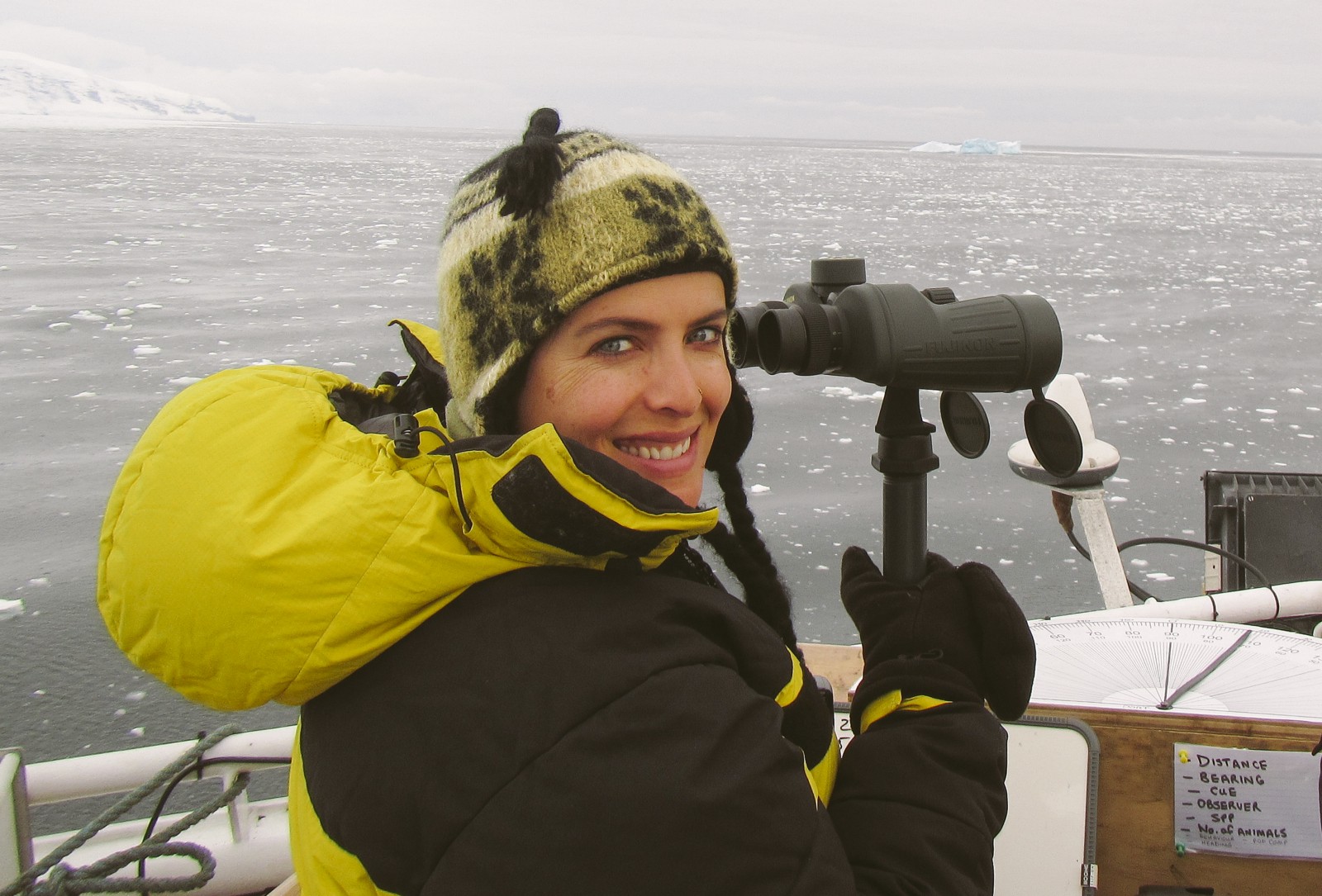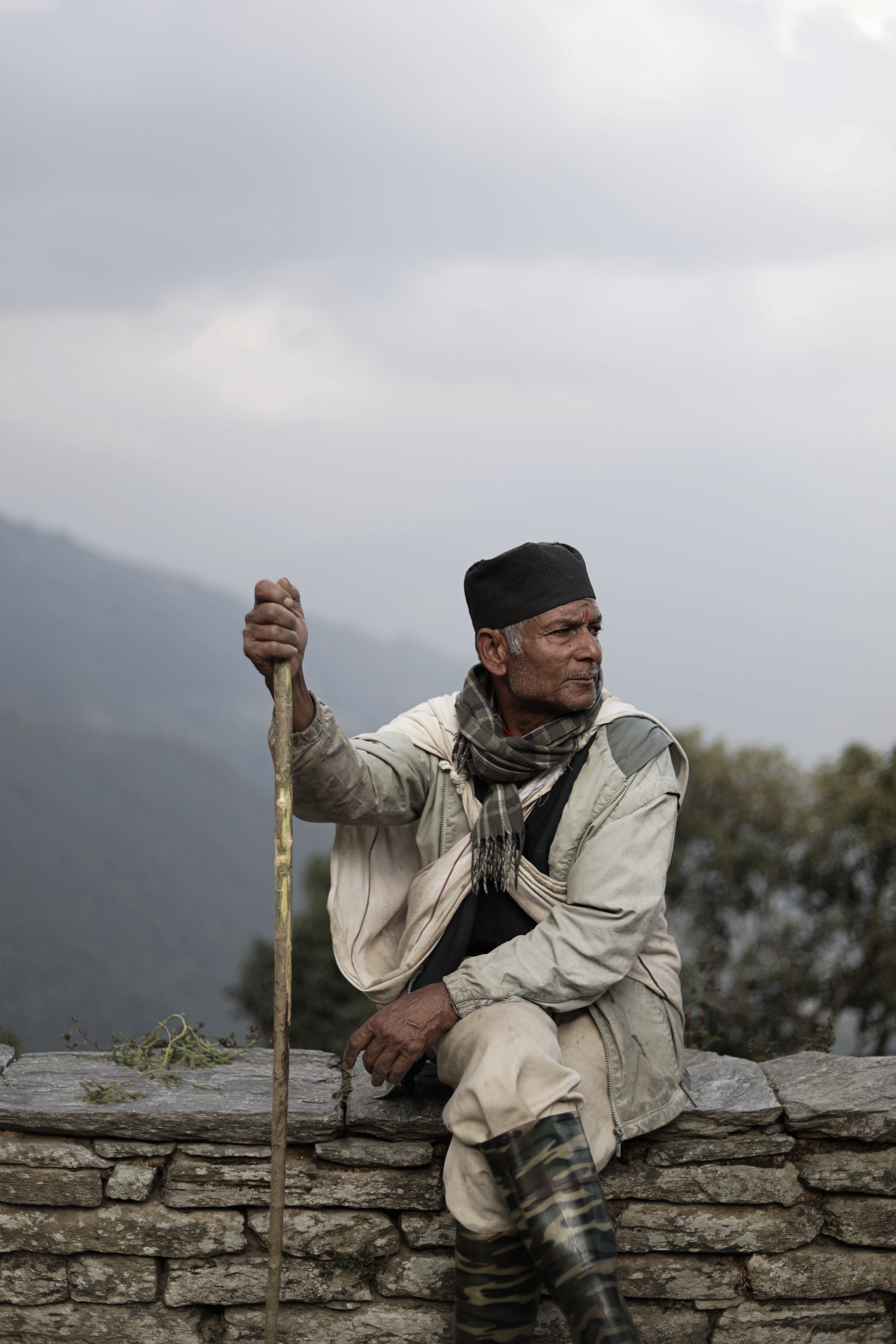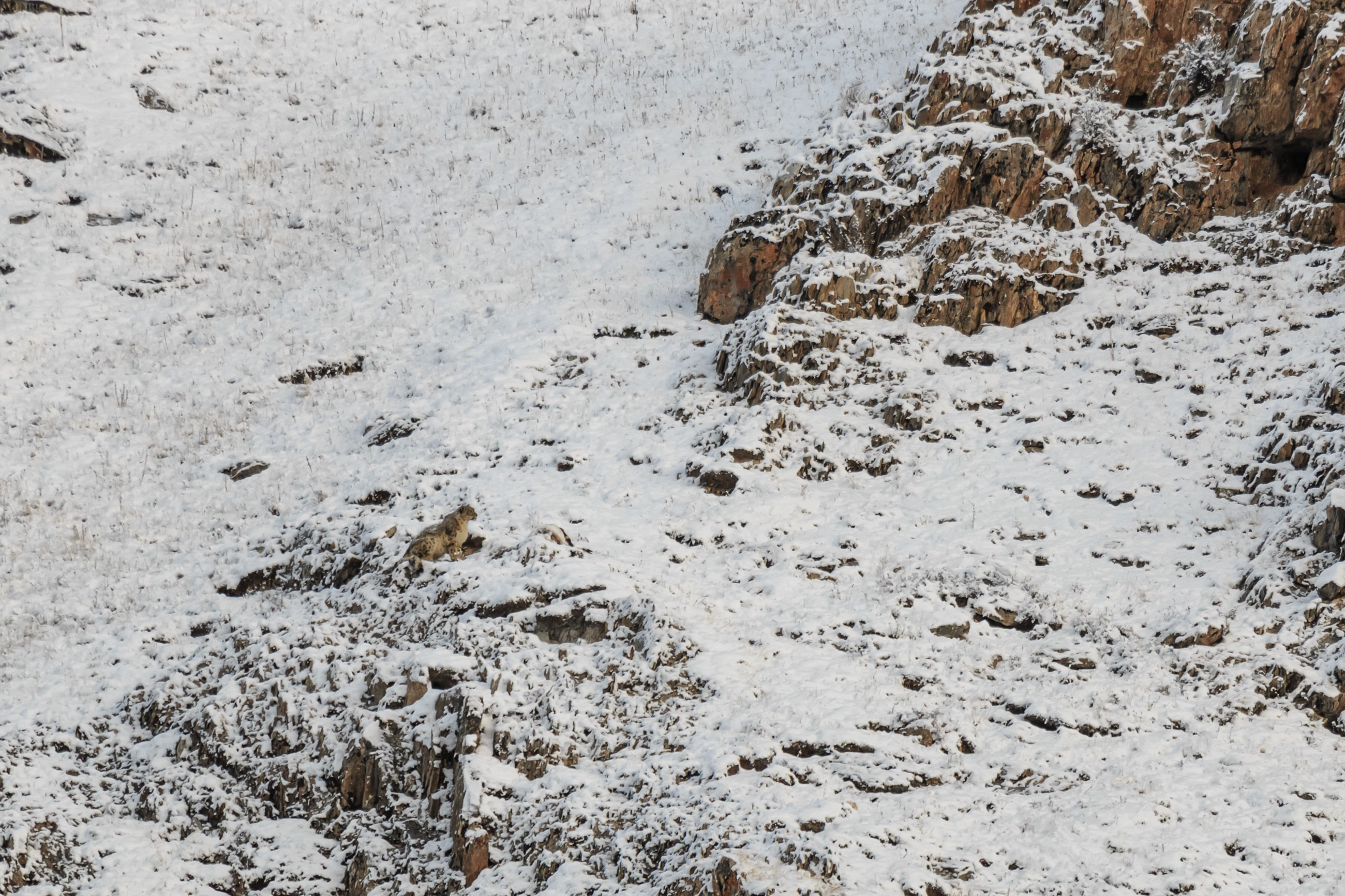The Snow Leopard is native to the mountain ranges of Central and South Asia and is listed as Vulnerable with less than 10,000 species left in the wild. © Frida Bredesen
From researching whales in Antarctica, to travelling the world as a TV presenter, and now developing a DNA toolkit for the detection of Snow Leopards in the wild, Natalie Schmitt’s professional career has taken her to some of the wildest places on earth, to research and report on some of the world’s most elusive species.
As a Conservation Geneticist, she has a passion for species preservation as well as communicating science to the general public — to help us better understand these species and to find ways to protect them.
Schmitt’s career started with a Zoology degree in Western Australia, evolved into becoming a TV presenter for the Discovery Channel, before taking a sharp turn back to science when she completed her Ph.D. on Humpback whales in Antarctica.

Natalie Schmitt researching Humpback Whales in Antarctica.
Determined to manage her own research project, Natalie began exploring potential whale projects but was discouraged by the politics involved. She decided to turned her attention to big cat conservation priorities, one of which was the need to find better ways of detecting one of the world’s most elusive big cats, the Snow Leopard, in the field.
This species is extremely challenging to find as it is rarely seen. One method is to collect faecal matter, however sending it away to labs for testing can take up to six months to yield results (particularly in developing nations). It was for this reason that Schmitt began to wonder if it would be possible to create a device that could produce immediate results.
Stumbling across a paper written by a medical lab at McMaster University in Canada (who had created a paper-based biosensor for the detection of bacteria in food and water samples), Schmitt thought about adapting that same method for the DNA detection of Snow Leopards.

Approximately 300 -400 Snow Leopard Species are believed to live in Nepal which hosts 30,000 km2 of potential Snow Leopard habitat. © Toomas Tartes
The scope of use would be vast, from detecting species in the field through to identifying illegally trafficked wildlife parts. By a stroke of luck, the professor at McMasters invited Schmitt to spend up to a year working in his lab to develop a proof of concept.
Schmitt is currently in Canada where she has been working to create a proof of concept for her DNA sample kit that will detect the DNA of the Snow Leopard in the field. Her hope is that the toolkit will transform the way we protect Snow Leopards as well as support the communities that live alongside them.
We caught up with Schmitt to find out how her project is going.
WildArk: What is it about Snow Leopards that you find so intriguing?
Natalie: It’s strange. I’m not a cold weather person and yet I feel attracted to cold weather places like Antarctica and the Himalayas. They are places no one goes, so the animals that survive in those harsh environment are fascinating to me. Snow Leopards are one of the most elusive mammals, in Nepal they call them the ‘Ghost of the Mountains’ because they are so rare, they are almost like a ghost when you see one. These types of animals have always intrigued me.
WildArk: Have you seen one in the wild?
Natalie:No!It is still early days, I’ve been to Nepal once and I’m planning on going back in October, so fingers crossed it will happen eventually.
WildArk: Why was visiting Nepal essential to your research?
Natalie:My initial trip was in 2017 when I worked alongside a lab in Kathmandu that has conducted a lot of research on Snow Leopards. I wanted to understand just what it’s like to perform this type of fieldwork and what some of the challenges were before I could design this device well.


Natalie visited Nepal to understand some of the challenges in the fieldwork of Snow Leopard detection. © (left) kamal-kant-kosariya; © (right) Giuseppe Mondi
WildArk: What did you do while you were there?
Natalie: I went up into an area in the north of Nepal, bordering Tibet called Mustang. I spent a bit of time around there talking to some of the local communities about whether they had seen Snow Leopards in the area and did some walking in the mountains which was one of the most challenging things I’ve ever done!
WildArk: In your opinion, how important are these communities to the conservation of Snow leopards?
Natalie: Involving communities in conservation work is an essential aspect of conservation to me, more so than science. That is why I have been developing a relationship with an organization in the US called Pangje, which is headed by Professor Som Ale who is Nepalese and who has spent much time working in remote communities in Nepal. Pangje does a lot of community work educating children about the importance of conserving Snow Leopards, and they have initiated credit programs that empower people and replace livestock taken by Snow Leopards. We are starting a community initiative in two villages, one in Mustang and one in Manang. And I’m going to be running some camera traps to determine how many Snow Leopards are around these villages and what impact these programs have on Snow Leopard conservation.
WildArk: What do you understand to be the biggest threats to Snow Leopards?
Natalie:I think in many parts of their range, poaching is a severe issue. In central Asia, poaching is one of the biggest threats to Snow Leopards, and in areas of Nepal and Northern India, there have been retribution killings as a result of Snow Leopards taking livestock. Increasingly, the building of roads and human population encroachment on habitat is becoming a more significant threat. Climate change is another big one where we are seeing common leopards encroaching on Snow Leopard territory and competing for their prey.
WildArk: Do the communities you’ve worked with see value in protecting Snow Leopards?
Natalie: Yes, I think deep down these communities respect Snow Leopards and in their past have lived in harmony with these animals. I believe the influence of the west and its modernity has seen communities forget how to live in harmony with this species, competing with them instead.

Snow leopards prefer to inhabit steep cliff areas, rocky outcrops and ravines that provide them with the camouflage they need to ambush unsuspecting prey. © Adobe Stock
WildArk: Why does developing this kit cost so much?
Natalie: We are estimating it will take 3–4 years to develop this toolkit. As its new and innovative technology, it requires a certain degree of experimentation, and therefore you need to allow a bit of room for error. I also need a team of people to help me, including a chemical engineer who can work on the paper to capture and immobilize the DNA. I need 1–2 students with this functional nucleic acid group who can help amplify the DNA and link back to a colour change and make the device as sensitive and specific as we can get it. I also need a team of people that can develop it for different species. Initially, we will prepare it for Snow Leopard, but our broader goal is to develop it for all the big cat species. We are now also hoping to create it for wolves because wolves have recently become a big issue in Europe. So it’s a massive team effort. The highest cost is paying peoples salaries, the research itself is not that expensive.
WildArk: What kind of support have you received from the conservation world?
Natalie:I’ve had incredible support. It’s been amazing and frustrating because these organizations can’t give me all the funding I need. WWF are interested in the technology for monitoring rare big cat species in Asia and the Caucasus and for detecting illegally trafficked items — they see that being the biggest application for something like this. I have support from the Global Snow Leopard Ecological Program (that represent all the Snow Leopard range countries) and the Ilbirs Foundation who focus on Snow Leopards in Kyrgyzstan. They are very keen on the technology to monitor Snow Leopards in the wild because few of these countries have access to laboratories that can conventionally identify faecal matter. There has also been industry support from an environmental impact standpoint. In Canada, the oil and gas industry is interested in Caribou; they want to find easy ways for their field officers to detect Caribou because it’s a species that is at risk in Canada and very important to this industry so they have endorsed this technology.

Natalie’s Snow Leopard DNA toolkit will help protect and manage Snow Leopard populations in the wild. © Anjali Mehta
WildArk: How long have you been working on this?
Natalie:It’s been three years and that’s the reason I won’t give up. I see so much application for this project and I’ve had so much support for the idea that I can’t give up, I have to keep going until I get it.
WildArk: Why is this tool so important to you?
Natalie:Unless we know where these animals are, we can’t protect them, and we can’t manage them. Human populations are growing at such an incredible rate that it’s becoming easier and easier to see this elusive species. We need to be able to manage them before we encroach too much on their territory.
WildArk: What do you feel about the state of the natural world?
Natalie:The natural world is severely challenged, according to the latest UN report, one million species are on the brink of extinction. My biggest concern with saving the planet and biodiversity is peoples’ disconnection from nature. As the human population grows and becomes more urbanised, more and more people are losing that connection and without that connection they don’t have the motivation to want to protect it. That is why I have such a passion for communicating and trying to involve the public in conservation work. It is more important than ever to find ways to connect the public with nature and find ways to make them care.
To support Natalie’s project or find out more click here.
